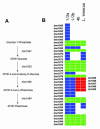Genome diversification in phylogenetic lineages I and II of Listeria monocytogenes: identification of segments unique to lineage II populations
- PMID: 12949110
- PMCID: PMC193770
- DOI: 10.1128/JB.185.18.5573-5584.2003
Genome diversification in phylogenetic lineages I and II of Listeria monocytogenes: identification of segments unique to lineage II populations
Abstract
Thirteen different serotypes of Listeria monocytogenes can be distinguished on the basis of variation in somatic and flagellar antigens. Although the known virulence genes are present in all serotypes, greater than 90% of human cases of listeriosis are caused by serotypes 1/2a, 1/2b, and 4b and nearly all outbreaks of food-borne listeriosis have been caused by serotype 4b strains. Phylogenetic analysis of these three common clinical serotypes places them into two different lineages, with serotypes 1/2b and 4b belonging to lineage I and 1/2a belonging to lineage II. To begin examining evolution of the genome in these serotypes, DNA microarray analysis was used to identify lineage-specific and serotype-specific differences in genome content. A set of 44 strains representing serotypes 1/2a, 1/2b, and 4b was probed with a shotgun DNA microarray constructed from the serotype 1/2a strain 10403s. Clones spanning 47 different genes in 16 different contiguous segments relative to the lineage II 1/2a genome were found to be absent in all lineage I strains tested (serotype 4b and 1/2b) and an additional nine were altered exclusively in 4b strains. Southern hybridization confirmed that conserved alterations were, in all but two loci, due to absence of the segments from the genome. Genes within these contiguous segments comprise five functional categories, including genes involved in synthesis of cell surface molecules and regulation of virulence gene expression. Phylogenetic reconstruction and examination of compositional bias in the regions of difference are consistent with a model in which the ancestor of the two lineages had the 1/2 somatic serotype and the regions absent in the lineage I genome arose by loss of ancestral sequences.
Figures






Similar articles
-
Identification and characterization of nucleotide sequence differences in three virulence-associated genes of listeria monocytogenes strains representing clinically important serotypes.Curr Microbiol. 1998 May;36(5):309-18. doi: 10.1007/s002849900315. Curr Microbiol. 1998. PMID: 9541569
-
Horizontal Gene Transfer and Loss of Serotype-Specific Genes in Listeria monocytogenes Can Lead to Incorrect Serotype Designations with a Commonly-Employed Molecular Serotyping Scheme.Microbiol Spectr. 2023 Feb 14;11(1):e0274522. doi: 10.1128/spectrum.02745-22. Epub 2022 Dec 6. Microbiol Spectr. 2023. PMID: 36472431 Free PMC article.
-
Identification of high-risk Listeria monocytogenes serotypes in lineage I (serotype 1/2a, 1/2c, 3a and 3c) using multiplex PCR.J Appl Microbiol. 2015 Sep;119(3):845-52. doi: 10.1111/jam.12876. Epub 2015 Aug 4. J Appl Microbiol. 2015. PMID: 26095922
-
Listeria monocytogenes lineages: Genomics, evolution, ecology, and phenotypic characteristics.Int J Med Microbiol. 2011 Feb;301(2):79-96. doi: 10.1016/j.ijmm.2010.05.002. Epub 2010 Aug 13. Int J Med Microbiol. 2011. PMID: 20708964 Review.
-
Listeria monocytogenes virulence and pathogenicity, a food safety perspective.J Food Prot. 2002 Nov;65(11):1811-29. doi: 10.4315/0362-028x-65.11.1811. J Food Prot. 2002. PMID: 12430709 Review.
Cited by
-
Selection and Characterization of Phage-Resistant Mutant Strains of Listeria monocytogenes Reveal Host Genes Linked to Phage Adsorption.Appl Environ Microbiol. 2015 Jul;81(13):4295-305. doi: 10.1128/AEM.00087-15. Epub 2015 Apr 17. Appl Environ Microbiol. 2015. PMID: 25888172 Free PMC article.
-
Genomic instability in regions adjacent to a highly conserved pch prophage in Escherichia coli O157:H7 generates diversity in expression patterns of the LEE pathogenicity island.J Bacteriol. 2009 Jun;191(11):3553-68. doi: 10.1128/JB.01738-08. Epub 2009 Mar 27. J Bacteriol. 2009. PMID: 19329643 Free PMC article.
-
Probing the pan-genome of Listeria monocytogenes: new insights into intraspecific niche expansion and genomic diversification.BMC Genomics. 2010 Sep 16;11:500. doi: 10.1186/1471-2164-11-500. BMC Genomics. 2010. PMID: 20846431 Free PMC article.
-
Reassessment of the Listeria monocytogenes pan-genome reveals dynamic integration hotspots and mobile genetic elements as major components of the accessory genome.BMC Genomics. 2013 Jan 22;14:47. doi: 10.1186/1471-2164-14-47. BMC Genomics. 2013. PMID: 23339658 Free PMC article.
-
Genomic deletion marking an emerging subclone of Francisella tularensis subsp. holarctica in France and the Iberian Peninsula.Appl Environ Microbiol. 2007 Nov;73(22):7465-70. doi: 10.1128/AEM.00646-07. Epub 2007 Sep 21. Appl Environ Microbiol. 2007. PMID: 17890329 Free PMC article.
References
-
- Aarts, H. J., L. E. Hakemulder, and A. M. Van Hoef. 1999. Genomic typing of Listeria monocytogenes strains by automated laser fluorescence analysis of amplified fragment length polymorphism fingerprint patterns. Int. J. Food Microbiol. 49:95-102. - PubMed
-
- Bibb, W. F., B. Schwartz, B. G. Gellin, B. D. Plikaytis, and R. E. Weaver. 1989. Analysis of Listeria monocytogenes by multilocus enzyme electrophoresis and application of the method to epidemiologic investigations. Int. J. Food Microbiol. 8:233-239. - PubMed
-
- Bishop, D. K., and D. J. Hinrichs. 1987. Adoptive transfer of immunity to Listeria monocytogenes: the influence of in vitro stimulation on lymphocyte subset requirements. J. Immunol. 139:2005-2009. - PubMed
Publication types
MeSH terms
Substances
Grants and funding
LinkOut - more resources
Full Text Sources

